

Times Square Cam - EarthCam. *****NYC Times Square, 1909. Flat Iron Building under construction, Times Square, New York City, 1903. 21st Century Challenges. What’s the challenge?
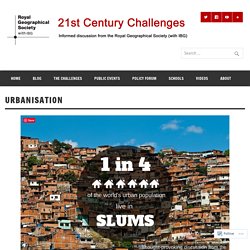
Humans are rapidly becoming an urban species, with millions of people migrating to cities each year. Over half of the world’s population live in urban areas and this is likely to reach 70% of the population by 2050. How will urban centres across the world keep pace with predicted continuing growth? What are the visions of tomorrow’s cities? FactsIn 2008 for the first time in history more people lived in cities than in rural areas.Slums are the world’s fastest growing habitat. Rural to urban migration Much of global urbanisation is due to rural-urban migration. The global proportion of urban population rose dramatically during the twentieth century: 1900 13% (220 million) 1950 29% (732 million) 2005 49% (3.2 billion) By 2030 this figure is estimated by the United Nations to be 60% (4.9 billion) Source: The UN World Urbanization Prospects (2009) Cities Slums.
The 100 million city: is 21st century urbanisation out of control? The 1960 street map of Lagos, Nigeria, shows a small western-style coastal city surrounded by a few semi-rural African villages.

Paved roads quickly turn to dirt, and fields to forest. There are few buildings over six floors high and not many cars. No one foresaw what happened next. In just two generations Lagos grew 100-fold, from under 200,000 people to nearly 20 million. Urban Geography: Why We Live Where We Do. The story of cities. 'Forest cities': the radical plan to save China from air pollution. When Stefano Boeri imagines the future of urban China he sees green, and lots of it.
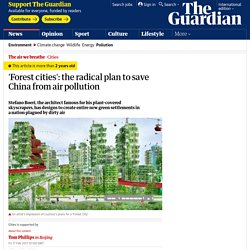
Growing mega-cities will displace vast tracts of farmland by 2030, study says. Our future crops will face threats not only from climate change, but also from the massive expansion of cities, a new study warns.
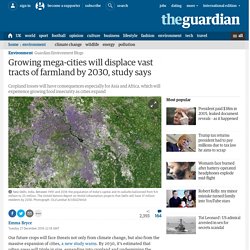
By 2030, it’s estimated that urban areas will triple in size, expanding into cropland and undermining the productivity of agricultural systems that are already stressed by rising populations and climate change. Roughly 60% of the world’s cropland lies on the outskirts of cities—and that’s particularly worrying, the report authors say, because this peripheral habitat is, on average, also twice as productive as land elsewhere on the globe.
“We would expect peri-urban land to be more fertile than average land, as mankind tends to settle where crops can be produced,” says Felix Creutzig from the Mercator Research Institute on Global Commons and Climate Change in Berlin, and principal author on the paper. The Observer view on London’s wealth gap. The cliche of London as a tale of two cities is well-worn.

But new research published by the Trust for London shows it is deservedly so. Striking new figures show that the proportion of households classified as either poor or wealthy has grown across the country in recent decades, leaving a shrinking middle. But it is in London that the trend is by far the most pronounced. Why Greater London should be made into an urban national park. Last year I visited all 15 of the UK's national parks.
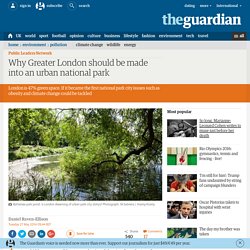
47 per cent of London is green space: Is it time for our capital to become a national park? High up on a grassy hillock alive with wild flowers, a man wearing a beard and sturdy shoes addresses more than 100 young explorers.
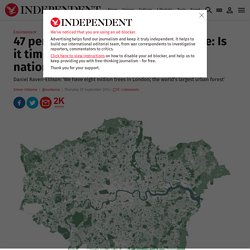
The sun strikes their faces and the surrounding landscape. It would be a scene of bucolic wonder were it not for the bottle tops and fag ends at their feet, the concrete and glass blocks that dominate the skyline, and the rumble of flight paths, railways and the frantic Mile End road. The Urban Wild Project - Green Roofs, London. The truth about London's air pollution. “In the morning, this traffic island is packed with children and pushchairs and they are about a metre from all the exhausts,” says Shazia Ali-Webber.
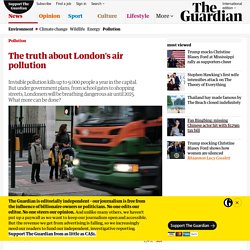
She is walking her three boys to school in Hackney, the eldest of whom, Zain, is eight and asthmatic. London Now London Future. À New York, un projet de ville entière contenue dans un gratte-ciel géant. L’un des projets du concours eVolo propose de construire un gratte-ciel géant à Times Square contenant un stade et une forêt artificielle.
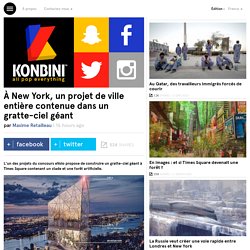
Dans le cadre du concours eVolo 2015, mettant en compétition différents projets de gratte-ciels originaux et innovants, celui d’un immense skyscraper futuriste à New York a été présenté. Il intègre des magasins, restaurants et immeubles, ainsi que des musées, un stade, une forêt ainsi qu’une plage artificielle. Le tout contenu dans une gigantesque structure en verre de plus de 1700 mètres. Soit une certaine idée de l’enfer ; sorte d’exacerbation effarante du Cauchemar Climatisé décrit par Henry Miller. Cette esquisse s’inscrit d’ailleurs dans la droite lignée des nombreux projets urbanistes et architecturaux sans âme qui ont essaimé aux États-Unis. Le skyscraper présenté pour le eVolo 2015 présente quant à lui une vision du Times Square de l’an 3015 – qui a peu à voir avec l’original.